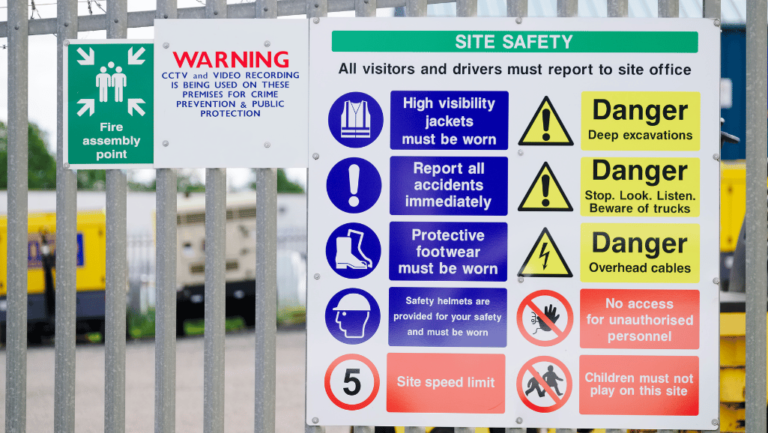Phone:
(+65)8319-0742
Welcome to our comprehensive guide to Scaffold Tagging Systems. In the ever-evolving construction industry, safety and compliance are paramount. Proper scaffold tagging plays a crucial role in ensuring the well-being of workers and meeting regulatory requirements. This guide will provide you with the knowledge and best practices necessary to implement an effective scaffold tagging system on your construction projects.
Scaffold Tagging Systems involve the use of safety tags to communicate important information about scaffolding status, inspection results, and safety precautions. By utilizing clear and standardized visual cues, these systems enable workers to easily assess the safety of scaffolds and take appropriate actions. From identifying potential hazards to tracking inspection dates, scaffold tags are an essential tool for maintaining a safe and compliant worksite.
Throughout this guide, we will explore the intricacies of Scaffold Tagging Systems and equip you with the information you need to implement them successfully. We will delve into the purpose and function of scaffold safety tags, discuss best practices for their placement and content, and explain the significance of scaffold tag colors. Additionally, we will emphasize the importance of scaffold inspections and how scaffold tagging can facilitate compliance with regulatory requirements.
Whether you are a contractor, supervisor, or worker involved in construction projects, understanding Scaffold Tagging Systems is crucial for ensuring safety and regulatory compliance. Let’s dive into the world of scaffold tags and discover how they can enhance your construction site’s safety protocols.
Key Takeaways:
- Scaffold Tagging Systems play a vital role in ensuring safety and compliance in construction projects.
- Scaffold safety tags provide clear visual cues to assess the safety of scaffolds and communicate important information.
- Proper placement and content on scaffold tags are essential for effective communication.
- Inspecting scaffolds regularly and documenting inspection results using scaffold tags is crucial for regulatory compliance.
- Understanding scaffold tag colors helps workers quickly identify safety status and take appropriate precautions.
Understanding Scaffold Tagging Systems
When it comes to ensuring safety and compliance in construction projects, Scaffold Tagging Systems play a crucial role. These systems rely on scaffold safety tags, which provide vital information about the condition and status of scaffolding structures. By implementing scaffold tagging best practices, construction companies can effectively communicate crucial safety information and prevent potential accidents.
Scaffold safety tags are not just decorative elements; they serve a purpose. These tags are strategically placed on scaffolding structures to convey critical information to workers, supervisors, and inspectors. One glance at a scaffold safety tag can instantly indicate whether the structure is safe to use or requires attention.
Implementing and managing scaffold tagging systems requires adherence to best practices. Firstly, tag placement is key. Safety tags should be affixed in a clearly visible location, easily noticeable by anyone accessing or approaching the scaffolding. This ensures that workers and contractors are aware of any safety concerns or specific instructions.
Scaffold safety tags should include essential information to communicate the condition of the scaffolding. This typically includes details such as inspection dates, the name of the responsible inspector or supervisor, and any necessary instructions or warnings. The information provided on the tags should be concise, clear, and unambiguous.
Clear communication about scaffold safety is vital, especially in construction environments where workers may be exposed to numerous hazards. Scaffold safety tags enable effective communication by using standardized visual cues and colors to convey specific messages. For example, a red safety tag may indicate that the scaffold is unsafe and should not be used, while a green tag may signify that the scaffold is in proper working condition.
Best Practices for Scaffold Tagging:
- Ensure scaffold safety tags are prominently displayed and easily visible.
- Include important information on the tags, such as inspection dates and responsible individuals.
- Use standardized color codes to convey specific safety messages.
- Regularly inspect and replace damaged or worn-out safety tags.
- Train workers and supervisors on the proper understanding and interpretation of scaffold safety tags.
By following these scaffold tagging best practices, construction companies can enhance safety awareness, prevent accidents, and maintain compliance with industry regulations. The use of scaffold safety tags as part of a comprehensive tagging system ensures that all workers can quickly assess the safety status of scaffolding structures, promoting a safer working environment.
Meeting Scaffold Inspection Requirements

Ensuring the safety and compliance of scaffold structures is of paramount importance in the construction industry. Scaffold inspections play a crucial role in identifying potential hazards and maintaining a secure work environment. To meet scaffold inspection requirements, it is essential to understand the guidelines set forth by the Occupational Safety and Health Administration (OSHA) and implement an effective scaffold tagging system. By adhering to OSHA scaffold tagging standards, companies can demonstrate their commitment to worker safety and avoid costly penalties or accidents.
OSHA scaffold inspection requirements mandate regular inspections of scaffold structures to assess their integrity and identify any potential risks. These inspections should occur before each work shift, after any alterations or repairs, and following adverse weather conditions that may affect scaffold stability. During inspections, all scaffold components, including platforms, guardrails, and access points, must be thoroughly examined. Inspectors must also assess the adequacy of the scaffold’s support system, such as the base plates and bracing.
Scaffold tagging systems serve as a powerful tool to facilitate compliance with scaffold inspection requirements. By incorporating scaffold tags into the inspection process, companies can enhance communication and ensure that scaffold structures are inspected regularly. Scaffold tags are typically color-coded and contain essential information about the inspection status, date of inspection, and the name of the person conducting the inspection. This system allows workers to easily identify if a scaffold has been inspected, providing them with confidence in its safety.
Implementing an effective scaffold tagging system involves:
- Setting clear protocols for conducting scaffold inspections regularly.
- Using standardized scaffold tags that comply with OSHA requirements.
- Ensuring proper tag placement on scaffolds for easy visibility.
- Training workers and supervisors on the importance of scaffold inspections and the proper use of scaffold tags.
By following these practices, companies can establish a culture of safety and accountability, minimizing the risk of accidents and injuries related to scaffold structures. Scaffold tags also serve as a valuable documentation tool, allowing companies to track and document scaffold inspection results over time. This record-keeping not only ensures compliance with regulatory requirements but also provides a historical reference for future inspections and maintenance.
In conclusion, meeting scaffold inspection requirements is crucial in maintaining a safe construction site. Implementing scaffold tagging systems that align with OSHA standards not only facilitates compliance but also enhances communication and documentation of scaffold inspection results. By prioritizing scaffold safety and conducting regular inspections, companies can create a safer work environment for their employees, minimizing risks and ensuring compliance with industry regulations.
OSHA Scaffold Tag Colors and their Meaning
| Scaffold Tag Color | Meaning |
|---|---|
| Green | Safe to use |
| Yellow | Caution – requires attention, may have limitations |
| Red | Unsafe – do not use |
Implementing Scaffold Tag Management Systems

Efficiently managing scaffold tags is crucial to ensure safety and compliance on construction sites. In this section, we will explore essential tools and methods for implementing an effective scaffold tag management system. We will also discuss the role of scaffold tag holders and other organizational systems that can streamline the tagging process.
Role of Scaffold Tag Holders
Scaffold tag holders play a vital role in securely displaying the scaffold tags and preventing loss or damage. These holders are typically made of durable materials such as plastic or metal and are designed to withstand the rigors of construction sites. By providing a secure attachment point for the tags, holders ensure that they remain visible and easily readable.
When choosing scaffold tag holders, consider the following:
- Material: Opt for holders made from sturdy and weather-resistant materials to withstand harsh environmental conditions.
- Attachment: Look for holders that offer secure attachment options, such as clips or straps, to prevent accidental displacement or removal.
- Visibility: Select holders that allow the scaffold tags to be clearly seen from different angles, ensuring easy identification.
- Compatibility: Ensure that the holders are compatible with the size and shape of the scaffold tags you are using.
By investing in high-quality scaffold tag holders, you can enhance the longevity and visibility of the tags, ultimately contributing to a more efficient tagging system.
Organizational Systems for Scaffold Tag Management
Implementing effective organizational systems can significantly streamline the management of scaffold tags. Consider the following tips:
- Categorization: Organize scaffold tags based on various categories, such as project location, date of issuance, or scaffold type. This will facilitate easy retrieval and monitoring of the tags.
- Storage: Utilize designated storage areas or cabinets to store unused tags. Keep them in a dry and secure location to prevent damage or loss.
- Tracking: Use a tracking system, such as a logbook or digital documentation, to record the issuance and return of scaffold tags. This will help track their usage and ensure compliance with tagging requirements.
By implementing efficient organizational systems, you can save time and effort when managing scaffold tags, leading to improved overall safety and productivity on construction sites.
| Benefits of Implementing Scaffold Tag Management Systems | Challenges of Scaffold Tag Management |
|---|---|
|
|
Understanding Scaffold Tag Colors

When it comes to safety tagging systems, scaffold tag colors play a vital role in communicating crucial information at construction sites. By understanding the meaning behind different scaffold tag colors, contractors and workers can quickly identify the status of scaffolding and take appropriate safety precautions.
Let’s explore the significance of scaffold tag colors and their corresponding safety messages:
1. Red
The red scaffold tag color is typically used to indicate that the scaffolding is unsafe and should not be used. It highlights the need for immediate attention and corrective measures to address any potential hazards or defects. Workers should strictly adhere to the safety protocols and refrain from accessing red-tagged scaffolding until it has been deemed safe.
2. Green
Green scaffold tags signify that the scaffolding has passed the necessary safety inspections and is safe to use. Workers can proceed with their tasks confidently, knowing that the structure is secure and meets the required standards. It is important to note that regular inspections should still be conducted to ensure ongoing safety.
3. Yellow
The yellow scaffold tag color indicates that there are certain limitations or special precautions associated with the scaffolding. This could include weight restrictions, specific access limitations, or temporary safety measures. Workers should carefully review the information provided on the yellow tag before using the scaffolding to ensure compliance with the specified guidelines.
4. Blue
Blue scaffold tags are commonly used during the erection or dismantling of scaffolding. They serve as a visual indicator that the scaffolding is still in progress and not yet ready for use. Workers should exercise caution and avoid accessing blue-tagged scaffolding until the proper completion and verification steps have been taken.
By embracing scaffold tag colors as part of a comprehensive safety tagging system, construction companies can enhance workplace safety and reduce the risk of accidents and injuries. These standardized colors provide clear visual cues that enable workers to make informed decisions and prioritize their well-being.
Remember, the proper implementation and understanding of scaffold tag colors are crucial components of an effective safety management program. Ensure that all workers are trained on the meaning and significance of each color and consistently reinforce the importance of following the designated safety procedures.
Conclusion
Throughout this guide, we have explored the significance of scaffold tagging systems in ensuring safety and compliance in construction projects. By implementing scaffold tagging best practices and adhering to inspection requirements, contractors can create a secure working environment for their workers. Scaffold tag management systems and an understanding of scaffold tag colors further enhance communication and provide clear safety messages at a glance.
It is crucial for construction professionals to recognize the importance of scaffold tagging systems in promoting safe work practices. Compliance with OSHA standards and regular scaffold inspections are essential components of a robust safety program. By referring back to this guide, contractors can stay updated on the best practices and guidelines for implementing scaffold tagging systems, thus minimizing the risk of accidents and ensuring a safe working environment.
Embracing scaffold tagging systems is not only a legal obligation but also a commitment to prioritizing the well-being of workers. As construction sites can present inherent hazards, it is imperative to have a systematic approach to ensuring safety. Scaffold tags serve as visual reminders to workers about the status of scaffolding and the safety precautions they should take. By implementing scaffold tagging systems, construction professionals can reduce the risk of accidents, enhancing both productivity and worker satisfaction.
FAQ
What is a Scaffold Tagging System?
A Scaffold Tagging System is a visual communication system used in construction projects to indicate the status and safety conditions of scaffolding. It typically includes the use of color-coded tags that convey important information about the scaffolding’s stability, inspection status, and potential hazards.
Why are Scaffold Safety Tags important?
Scaffold Safety Tags play a crucial role in ensuring the safety and compliance of construction projects. They provide a visual indicator of the condition of the scaffolding and communicate important information to workers, supervisors, and inspectors. By using scaffold safety tags, organizations can increase awareness of potential hazards and take the necessary precautions to prevent accidents and injuries.
What are some best practices for implementing Scaffold Tagging Systems?
To implement Scaffold Tagging Systems effectively, it is important to follow some best practices. These include placing tags in highly visible locations, using durable and weather-resistant tags, providing clear and concise information on the tags, and regularly inspecting and updating the tags as needed. Additionally, proper training and education on scaffold tagging procedures should be provided to all workers involved in scaffolding operations.
What are the inspection requirements for Scaffold Tagging Systems?
Scaffold Tagging Systems should comply with the inspection requirements set by the Occupational Safety and Health Administration (OSHA). OSHA requires that scaffolding be inspected by a competent person before each work shift and after any incident or adverse weather condition that may affect the scaffold’s integrity. Scaffold tags play a crucial role in tracking and documenting these inspections, ensuring compliance with OSHA standards.
How can Scaffold Tag Management Systems be implemented effectively?
Implementing an effective Scaffold Tag Management System involves utilizing scaffold tag holders and other organizational systems. Scaffold tag holders provide a secure and easily accessible location for storing and displaying scaffold tags. Additionally, having a clear procedure for tagging, tracking, and replacing tags when necessary can streamline the management process, ensuring that scaffold tags are up to date and readily available.
What do different scaffold tag colors signify?
Scaffold tag colors have specific meanings in safety tagging systems. The exact color scheme may vary depending on the organization, but commonly used colors include green for “safe to use,” yellow for “caution or temporary hazard,” and red for “do not use or danger.” By understanding the meaning behind different scaffold tag colors, workers can quickly assess the safety status of scaffolding and take appropriate actions to protect themselves and others.



















